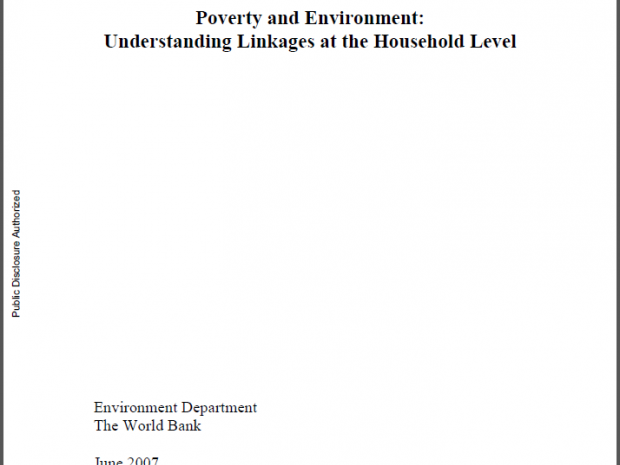Poverty and the Environemnt: Understanding Linkages at the Household Level (Overview, World Bank, 2008)

The World Bank’s fundamental goal is poverty reduction. While the Bank participates in lending and development through many different types of activities, it is important to examine these practices through a poverty lens. In 2002, some 50 percent of the global population subsisted on less than $2 a day. Approximately 44 percent of all households in Africa and 31 percent of people in South Asia lived below the dollar-a-day poverty line (WDI 2006). As these figures suggest, the Bank’s poverty mandate remains vast, important, and urgent.
The Bank is also one of the largest international donors in the area of environmental management. Last year alone, the Bank provided $1.4 billion (in either loans or grants) in aid to poor countries to improve the environment. The Bank’s activities in this arena include lending for forestry operations; improvements in air quality; changes in environmental institutions and governance; and investments in water and sanitation infrastructure. In partnership with the Global Environment Facility (GEF), the Bank plays a major role in global efforts to stem climate change, biodiversity degradation, and toxic and chemical waste impacts.
The question is whether these large investments in poverty reduction and environmental management are mutually reinforcing. History ultimately will provide an answer; in the meantime, there are smaller issues that can be addressed now. An important component of this question, for example, is whether—and to what extent—environmental management can contribute to poverty reduction. Are current environmental management strategies successful in addressing the problems of the poor, and what challenges do they face? And, most importantly, what is the role of the poor and their behavioral strategies as management programs are put forth?
Poverty reduction is a three-part problem. It involves (1) stemming the fall of households into further poverty, (2) enabling movements out of poverty, and (3) ensuring that the non-poor do not become poor. Reducing vulnerability is as important as reducing poverty. While there is a role for environmental management in each of these areas, the importance and type of management will differ. It is important to take a microscopic view of the poverty-environment problem and to understand how households rely on the environment, what factors condition household dependence on the environment, and the extent to which improvements in environmental management change the choices faced by the poor. These questions are at the core of this report. We focus on two classes of poverty-related welfare outcomes: (1) the more usually identified income and expenditure measures, and (2) health outcomes. Our attention to household-level analyses and actions distinguishes this report from other more broad-based analyses.
This document is the sole property of The World Bank and it is made available on this site in the only aim of knowledge sharing.
You can find more information on: http://www.worldbank.org/
Log in with your EU Login account to post or comment on the platform.